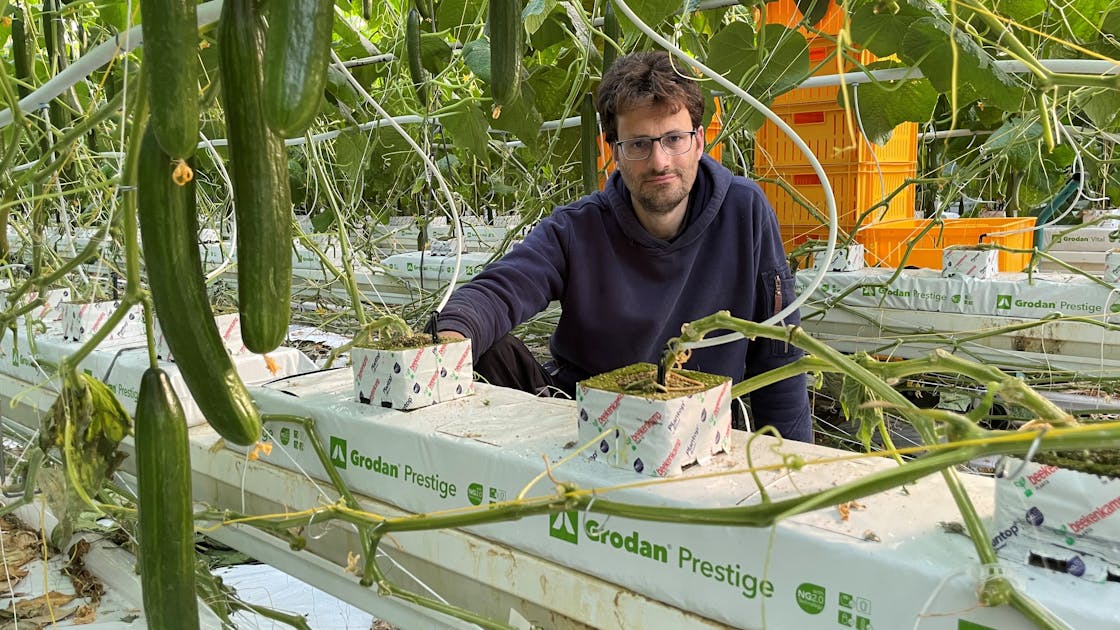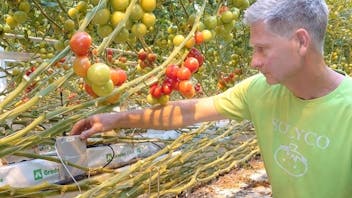Thirsty cucumbers
The blocks containing the young plants are placed straight onto stone wool slabs as soon as they arrive. “Cucumbers tend to be thirsty plants, so we give them plenty of water to encourage them to take root. This doesn’t take long; we can ease off after a couple of days and let the roots do their work. In the summer, the plants often start flowering after just seven or eight days and we can be harvesting the first fruits after 18 or 19 days.”

Bursting with hair roots
Tuinderij Vahl has been using stone wool growing media from Grodan for almost as long as Dries can remember. “It’s a long time – I was still at school! It must be around 30 years now,” he says. “The technical consultant from Grodan visits us a couple of times a year and we have regular contact for support or advice – especially towards the end of each year. We used to work with the Master slab , but we switched to the 7.5cm-high Grodan Prestige slab at the start of the 2020 season, so this is our second year,” continues Dries. “What I like about the Prestige is that it has a softer top layer so the roots seem to grow vertically down into the slab more quickly, rather than growing horizontally at first. You see roots appearing at the edges of the slab sooner, so it’s as if the plant makes better use of the whole slab. And especially in the summer there are lots of hair roots in the slab, and that’s what I look out for as a sign of plant health.”
Rapid initial growth and vegetative vigour
The Grodan Prestige is the ideal slab for growers who want rapid initial growth at the start and vegetative vigour in the summer, and this is a good fit with the approach at Tuinderij Vahl. “We tend to steer vegetatively, especially for our high-wire crop. The slab retains its weight well under various radiation and temperature conditions and it’s pretty easy to manage the EC level too,” states Dries. “But we’re careful not to let the slab dry out too much overnight, so we give a couple of night-time waterings. Our aim is to limit the drying-out to maximum 5 or 6%, although the Grodan technical advisor has told us that we could probably let the slab dry out a little more. High-wire cultivation already places greater demands on the plant because you extend the stem, so I don’t want to put extra pressure on the roots unnecessarily. I’d rather have a little bit too much vigour left over than not enough because that’s easier to correct, such as by removing an extra leaf for example.”
The extra demands of high-wire production also increase a crop’s susceptibility to pests and diseases, according to Dries: “And this will become a bigger issue when we’re no longer able to use our current fungicide against mildew next year. We’re currently thinking about switching to mildew-resistant varieties as one solution. But a strong root zone is essential to support a plant’s natural resilience, and the slab plays a role in that of course. Actually, I had noticeably less of a problem with pythium and fusarium last year.”
Long-lasting performance
“Another benefit of the Grodan Prestige for us is that it’s a good-quality slab that continues to perform well right through until the end of the season. That’s important because we work with two cycles for our high-wire crop, with plantings from mid-January and mid-June, and with three cycles for conventional cucumber production, with plantings in mid-January, late April and late July. All in all, the Grodan Prestige is a very dependable slab that’s easy to work with and offers a good price/quality ratio,” he states.
Sustainability
At the end of each season, as part of the recycling service offered by Grodan, the used blocks and slabs are picked up by a local waste collection company and taken to the central depot for sorting and separation. “We’ve been using this service for many years. The stone wool is turned into bricks, and that’s a good fit with our strong commitment to sustainability,” says Dries. For example, Tuinderij Vahl uses geothermal energy to heat some of the greenhouses, biofuel for others and also has a cogeneration unit to generate its own electric power, heating and CO2. Moreover, in 2019, the company added 2.5 hectares of fully organic production where it grows tomatoes one year and peppers the next. “Our customers find it important that we do our bit for the environment, but it’s something we ourselves strongly believe in too. The Grodan recycling service offers good value for money and helps us to be ‘planet-proof’, so it’s a win-win situation,” he concludes.










